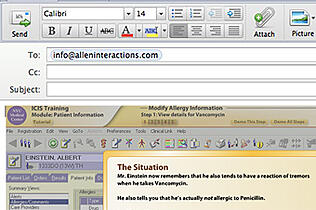Blog
All the World’s a Stage—Becoming a Better e-Learning Designer
At Allen Interactions, we strive to be a resource for instructional designers looking to make better, more effective e-learning designs. These ...


Ethan Edwards Answers Your e-Learning Design Questions
By Allen Interactions | January 23, 2015 | Custom Learning | 0 Comments

At Allen Interactions, we strive to be a resource for instructional designers looking to make better, more effective e-learning designs. These questions were submitted by attendees of Ethan Edwards' recent webinar "5 Secret Tips to Drive Impactful e-Learning Designs". If you missed the webinar and would like to view the recording, check out the on-demand webinar here.
How can I get more training in learning design?
There are many different sources of training, but I’m not sure that any are sufficient on their own. A gr
eat place to start is to take the professional workshops presented by ATD on designing learning and e-learning instructional design. There are also a number of certificate and degree programs offered by brick and mortar universities as well as online institutions. And we offer a premium training webinar and accompanying guide on design thinking. Even if you don’t want to pursue a degree, taking a few classes can be a good way to gain exposure to basic information about designing e-learning. But probably, the most important thing is to get involved with other professionals engaged in creating online learning and learn through interaction with them. Local ATD chapters, e-Learning Guild events and forums, and Training Magazine are all excellent resources for making connections and being exposed to the best ideas.
How can I apply these e-learning design principles to software training?
These principles apply directly to training software. The core of the training needs to be focused on letting the learners prove they can perform the tasks. So begin by figuring out how you will create a simulated environment. Usually this involves using screen shots of the actual software and creating hot-spot interactions in sequence to recreate the sequence of gestures required to perform the task. Then, consider how the learner could be benefited by providing help or other resources to clarify the task. But don’t force the student through those sequences; instead let each student decide what help is needed. Don’t feel the need to score each gesture or provide approval through judgment. The only feedback really necessary is to show the consequence, in the software, as to what happens next. The student can be given credit if she is able to complete the entire procedure without requiring help. It also helps to create additional meaning for the learner by providing context as to why a particular software procedure is useful. There’s a software training example you can access from our e-learning demos.
How do you handle policy e-learning so it’s more interactive instead of boring?
Policy learning faces the same challenges as any other sort of learning. The key is not to start with the policy. First, think about how the policy impacts the learner. Create a challenge around what is most interesting. For example, let’s consider teaching your company’s Confidentiality Policy. If you start by lecturing about the formal policy, you are unlikely to connect in any meaningful way with the audience. Instead, start with a case study. Let the learner make choices or judgments about a situation where people are making decisions regarding confidential information. Don’t make it obvious, but write it in a way that you hope learners will choose or experience some less-than-ideal consequences of poor information control. As they grapple with the aftermath, that creates the opportunity to introduce the policies to prevent those problems. Again get the learner actively making decisions for which the policies are the key to achieving success.
Many examples you show include gaming elements. We don't have the option to do that. How would the same thing be done without gaming?
These are gaming elements only if you describe them as such. If gaming is forbidden in your organization, then you might want to call this approach “creating immersive learning environments.” I’m only half kidding; the words we use can have huge impact on perception. More accurately, I would say these design ideas are elements that enhance learner engagement, improve motivation, and elevate meaning, which are all critical elements in any teaching effort. Challenging learners upfront and then letting them access supporting resources as necessary is simply a different choice in how you set expectations for learner success. It would be a very strict and controlled environment, indeed, if you didn’t have the option to do that. Very few of the lessons we create are set out initially as games. In fact, the bus driving example I showed at the end, which does share elements with some games, was not created as a game nor is it marketed to learners as a game. You may want to look into other resources on our website that talk about instructional interactivity. The elements of CCAF-based Design (Context, Challenge, Activity, and Feedback) combine in ways that might suggest gaming, but are specifically targeted for instructional purposes.
.png?width=135&height=135&name=ai-symbol-green%20(3).png)
About the Author: Allen Interactions
Comments
Would you like to leave a comment?
Related Blog Posts

By: Allen Interactions | Feb, 2015
Category: Custom Learning

Blog
3 Reasons To Attend ATD's E-Learning Instructional Design Training
At Allen Interactions, we strive to be a resource for instructional designers looking to make better, more effective e-learning designs. These ...
By: Allen Interactions | Jul, 2015
Category: Custom Learning

Blog
Helping You Combat the 10 Ways to Ruin e-Learning
At Allen Interactions, we strive to be a resource for instructional designers looking to make better, more effective e-learning designs. These ...
By: Allen Interactions | Jun, 2013
Category: Custom Learning

